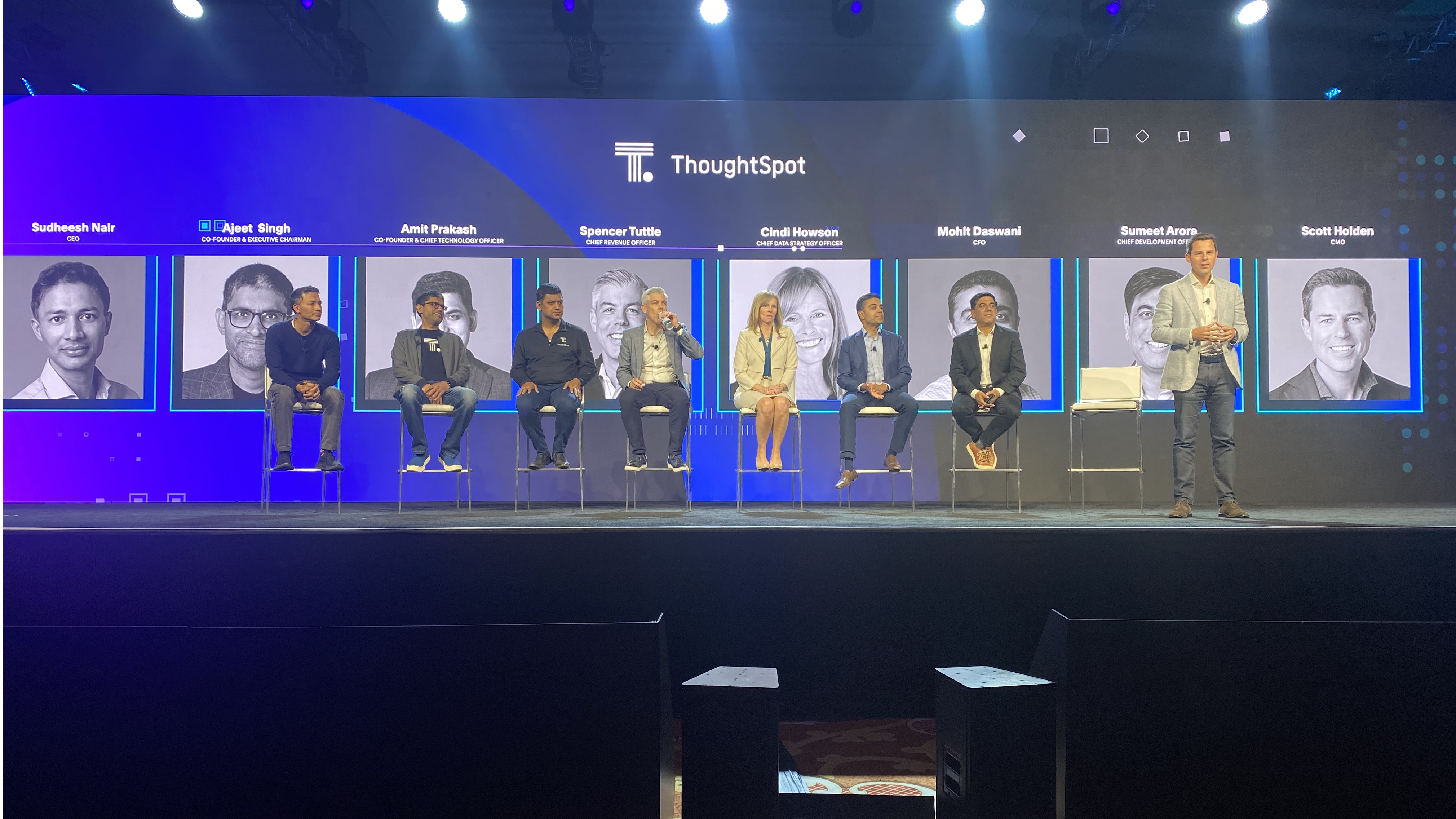Businesses can now use data cloud analytics to offer hyper-personalized services
Why analytics needs to be the actual experienced product in a data-driven world

The vast shift to cloud computing over the last few years has accelerated digital transformation for many businesses, which in turn, has caused the production of copious amounts of data.
In the past, these more manageable heaps of on-premise data just wasn’t there - but the widespread move to the cloud has made building everything in one place much easier, as well as enabling the rise of live analytics.
By 2023, 50% of all business workloads are expected to run in the cloud. SWZD also found that 53% of all organizations accelerated cloud migration due to the business impact from COVID-19.
Despite this, Sudheesh Nair, CEO of ThoughtSpot, seems to think that many businesses are still doing old school analytics on top of new data.
The company projects that over the next 10 years, there will be no option for businesses but to be data driven - so how do they make this move?
Dominating the decade of data
ThoughtSpot recently announced its collaboration with dbt, a hosted service that helps data analysts and engineers productionize dbt deployments.
ThoughtSpot customers on dbt Cloud and dbt Core will be able to access the integration directly from the company’s newly enhanced Data Workspace for all things live analytics. Users now have the luxury of connecting to their cloud data platform, creating searchable views with their own custom SQL commands, and shipping their analytics-ready dbt data model to business users throughout their organization.
Are you a pro? Subscribe to our newsletter
Sign up to the TechRadar Pro newsletter to get all the top news, opinion, features and guidance your business needs to succeed!
Sean Zinsmeister, SVP Product Marketing at ThoughtSpot is confident that this dynamic will help open up the world of data to more and more business users, raising their level of data fluency, enabling them to make timely insights-driven decisions.
“The ThoughtSpot Data Workspace is specifically designed to empower analytics professionals to put their data to work and operate more efficiently. By seamlessly integrating with their dbt models on either dbt Core or dbt Cloud, their work is streamlined,” he told TechRadar Pro at the company’s recent Beyond 2022 event in Las Vegas.
“The integration detects table relationships from dbt, generate a scriptable TML (ThoughtSpot Modeling Language) representation of the dbt model, automatically generate a worksheet metadata model in ThoughtSpot, and instantly enable users to start searching on the data and building Liveboards. Data teams are able to boost productivity, while dramatically hastening the development and delivery of new analytics projects.”
In the past, people have been scared of data, and really only paid attention to data to sound smarter when putting a bunch of pie charts in a presentation, ThoughtSpot’s CEO told TechRadar Pro.
“Most people make decisions first, then find the data that justifies the decisions they already made. The problem in the new world is that there are so many data points coming and everything is already providing data,” explained Nair.
“If you were to go to a movie theatre 10-years ago and watch a movie, all they would know is that you bought a ticket and went in. Is it possible that you hated the movie within the first 10 minutes and walked out? Is it possible that it was so boring, you slept throughout the movie? No one knows. There was no way for them to get that feedback. So they would just pay money to the best director, the brand and award winners and give them money to keep building.”

Moving with data
Over the years, how data is being used has drastically evolved. Streaming companies like Netflix or Disney+, for example, are able to track viewing patterns and use that insight to make more informed decisions on the content shared on its platform.
“Creativity should never be influenced by so much data that it becomes a mechanical process but at the same time, smart producers may use the data to make better decisions on what sort of content they should be creating. This example applies to other verticals too,” Nair noted.
“If you want to build better services and experiences for your users, that opportunity now exists in every single vertical, and if you don’t, the chances of your succeeding will be very small.”
Cloud is the cause
As companies embrace the modern data stack, fueled by the explosion of data and race to the cloud, Zinsmeister observes data professionals prioritizing managing increasingly complex data engineering and analytics work.
“Companies that are dominating this new decade of data understand the value of the entire modern data stack, and are poised with a modern experience later to bring all the disparate pieces of their stack together,” Zinsmeister said.
“Each tool in the modern data stack creates value on its own for the data practitioner, but where the true ROI lies, is with how it reaches the business user on the frontlines.”
Research from Harvard Business Review found that 87% of business executives say their organization will be more successful when frontline workers are empowered to make important decisions in the moment, and 86% say frontline workers need better technology-enabled insight to do this. Self-service analytics is what enables this motion.
“This is where the opportunities lie to build AI-driven apps and experiences that are right for your users. Analytics as code is a popular movement, and we are addressing it with our embedded solution, ThoughtSpot Everywhere, which makes it easy to build interactive data apps or embed search and AI into your existing SaaS apps,” Zinsmeister continued.
“The modern data stack is all about best of breed, and we’re giving users the tools they need to launch a compelling data app with a unique UX that drives user engagement.”
ThoughtSpot meets Google Cloud
The data analytics firm recently expanded its relationship with Google Cloud to support BigQuery, and their data modeling offerings from Looker.
“Cloud essentially made it possible for ThoughtSpot to build services that are really quick and turn it on without requiring massive investments,” explained Nair.
“The ability to do hyper-personalization is a function of data, AI and cloud coming together. Once users experience that kind of service, they will not want to go back to the service they were receiving before. People no longer want to be treated as just another number, they want to be treated as a person.”
Nair strongly believes that up and coming companies that want to take on large competitors need to focus on making sure their infrastructure, data and insights are at an advantage for the business.
“If you are a small or large business, you have to start thinking how you can turn your infrastructure into a competitive differentiator for your business,” he continued.
“In Europe, payment services are a great example. There are so many Scandinavian buy now pay later companies like Klarna and Afterpay coming in and taking market share from the largest banks because they have turned infrastructure data and services into an advantage.”
Data insights? Challenge accepted
Businesses are not able to use Supermetrics to work with Google to deliver performance marketing as a use case. If a business runs a campaign, typically it will need to know if the money that has been spent on a Facebook ad for example, will yield tangible results and shell out a good return on investment.
ThoughtSpot is building specific solutions with Google and Supermetrics to be able to use data to provide such answers to those who need it.
As powerful as data can be, it’s only as good as its quality and how that quality is presented. These caveats have made the case for more interactive methods of analyzing data, which is something ThoughtSpot wants all businesses to strive for.
- Choosing the best cloud storage service is one of the key ways to keep your files safe and accessible online

Abigail is a B2B Editor that specializes in web hosting and website builder news, features and reviews at TechRadar Pro. She has been a B2B journalist for more than five years covering a wide range of topics in the technology sector from colocation and cloud to data centers and telecommunications. As a B2B web hosting and website builder editor, Abigail also writes how-to guides and deals for the sector, keeping up to date with the latest trends in the hosting industry. Abigail is also extremely keen on commissioning contributed content from experts in the web hosting and website builder field.